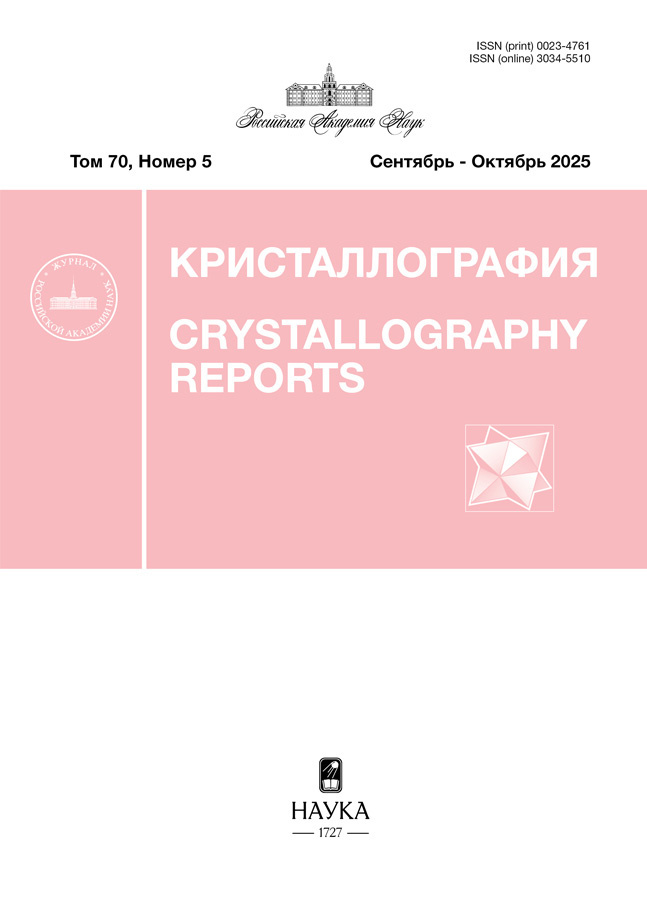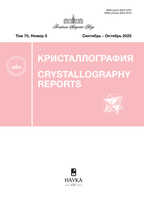Kristallografiâ
A peer-reviewed journal that publishes original articles, short communications, and reviews on various aspects of crystallography: diffraction and scattering of X-rays, electrons, and neutrons, determination of crystal structure of inorganic and organic substances, including proteins and other biological substances; UV–Vis and IR spectroscopy; growth, imperfect structure and physical properties of crystals; thin films, liquid crystals, nanomaterials, partially disordered systems, and the methods of studies.
The journal was founded in 1956.
Media registration certificate: № 0110215 от 08.02.1993
Founders: Russian Academy of Sciences, Shubnikov Institute of Crystallography of RAS
Editor-in-Chief: Michail V. Kovalchuk, corresponding member RAS, Doctor of Sc., Full Professor
Frequency / Access: 6 issues per year / Subscription
Included in: White list (2nd level), Higher Attestation Commission list, RISC
Edição corrente
Volume 70, Nº 5 (2025)
- Ano: 2025
- Artigos: 21
- URL: https://cardiosomatics.orscience.ru/0023-4761/issue/view/14164
Edição completa
ДИФРАКЦИЯ И РАССЕЯНИЕ ИОНИЗИРУЮЩИХ ИЗЛУЧЕНИЙ
A new method of phase-contrast microscopy of microobjects using a nanofocusing lens in synchrotron radiation
Resumo
 715-721
715-721


REAL STRUCTURE OF CRYSTALS
Defects initiating fatigue faults in granular alloy EP741NP (part II)
Resumo
 722-731
722-731


СТРУКТУРА НЕОРГАНИЧЕСКИХ СОЕДИНЕНИЙ
STRUCTURAL FEATURES OF TRIS(ETHYLENEDIAMINE)NICKEL(II) DICHLOROIDE DIHYDRATE SINGLE CRYSTALS IN THE TEMPERATURE RANGE 85–293 K
Resumo
 732-735
732-735


DISSYMMETRIZATION IN EUDIALYTE-GROUP MINERALS. V. CRYSTAL STRUCTURE OF POTENTIALLY NEW MINERAL FROM MOROCCAN PEGMATITE – FIRST HIGH CALCIUM MEMBER WITH Р3-SYMMETRY
Resumo
 736-743
736-743


STRUCTURE OF MACROMOLECULAR COMPOUNDS
Composite perfluorinated membranes modified by polyvinyl alcohol cross-linked with sulfosuccinic acid
Resumo
 744-758
744-758


ДИНАМИКА РЕШЕТКИ И ФАЗОВЫЕ ПЕРЕХОДЫ
Dynamics of metal-semiconductor and reverse semiconductor-metal phase transitions in sms thin films induced by mechanical and thermal influences
Resumo
 759-766
759-766


ФИЗИЧЕСКИЕ СВОЙСТВА КРИСТАЛЛОВ
Surface properties and nucleation of linear acene crystals under growth from vapor and solution
Resumo
 767-782
767-782


Electrophysical Properties Anisotropy of La3Ga5SiO14 Langasite Crystals Doped with Cr and Mn Ions
Resumo
 783-789
783-789


Anisotropy and microscopic aspects of ion transport in Li2B4O7 crystals
Resumo
 790-799
790-799


ПОВЕРХНОСТЬ, ТОНКИЕ ПЛЕНКИ
Studying the X-ray absorption fine structure spectra of a protein monolayer on liquids. The possibilities of multi-pass technique.
Resumo
 800-809
800-809


Partially Disordered Crystalline State in a Thin Ge2Sb2Te5 Film: Manifestation of Thermally Induced Nanoscale Effect
Resumo
 810-816
810-816


НАНОМАТЕРИАЛЫ, КЕРАМИКА
Preparation of entropy-stabilized fluoride phases of fluorite structure by coprecipitation from aqueous
Resumo
 817-823
817-823


Conduction Band Electronic States of Fluorine-Substituted Furan-Phenylene Co-Oligomer Film on the Surfaces of Silicon and Zinc Oxide
Resumo
 824-829
824-829


A New Approach for Synthesizing Ultrathin Hexagonal Boron Nitride Nanoparticles Through Two-Step Thermal Treatment
Resumo
 830-836
830-836


CRYSTAL GROWTH
Growth Features of the Guanylurea Hydrogen Phosphite Single Crystal
Resumo
 837-845
837-845


Growth and Some Properties of Mixed Crystals of Non-Isostructural Series of Nickel and Cobalt Sulphates Hexahydrates
Resumo
 846-855
846-855


Thermoluminescence of dense β-Ga2O3 ceramics synthesized by gas-thermal spraying
Resumo
 856-864
856-864


ПРИБОРЫ, АППАРАТУРА
COMPLEX STUDY OF THE INTERNAL STRUCTURE OF POLYMERIC SPONGE MATRIXES IN THE PROCESS OF A TISSUE-ENGINEERED ARRAGEMENT
Resumo
 865-873
865-873


Experimental Setup for Synchrotron Studies of Materials under Influence of External Magnetic Fields
Resumo
 874-880
874-880


The design of the crystals structure study. I. Optimization of data collection on modern diffractometers
Resumo
 881-889
881-889


COMBINING THE RESULTS OF NEUTRON AND SYNCHROTRON TOMOGRAPHY
Resumo
 890-896
890-896













